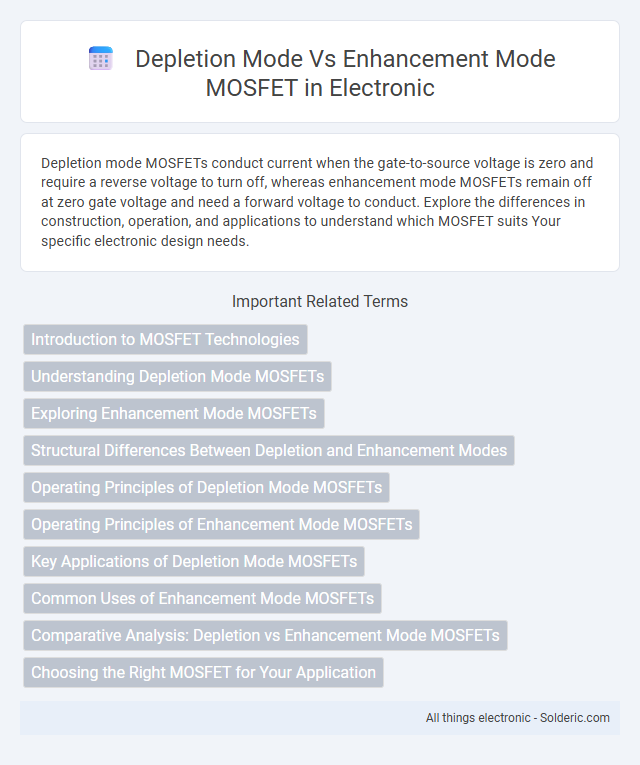Depletion mode MOSFETs conduct current when the gate-to-source voltage is zero and require a reverse voltage to turn off, whereas enhancement mode MOSFETs remain off at zero gate voltage and need a forward voltage to conduct. Explore the differences in construction, operation, and applications to understand which MOSFET suits Your specific electronic design needs.
Comparison Table
| Feature | Depletion Mode MOSFET | Enhancement Mode MOSFET |
|---|---|---|
| Operating Mode | Normally ON (conducting) at zero gate-source voltage | Normally OFF (non-conducting) at zero gate-source voltage |
| Channel Type | Pre-existing channel | No channel at zero gate voltage |
| Gate Voltage Effect | Negative gate voltage reduces current (depletes channel); positive enhances it | Positive gate voltage creates channel and allows current flow |
| Symbol | Channel line present | Channel line absent |
| Usage | Analog switches, current regulators | Digital circuits, switching applications |
| Threshold Voltage (Vth) | Negative or zero | Positive |
Introduction to MOSFET Technologies
Depletion mode MOSFETs operate with a normally-on channel that requires a gate voltage to deplete carriers and turn off the device, contrasting with enhancement mode MOSFETs which have a normally-off channel activated by a gate voltage that enhances carrier flow. Both technologies are fundamental in semiconductor devices for switching and amplification, with enhancement mode MOSFETs dominating digital logic applications due to their power efficiency and ease of control. Advances in MOSFET fabrication focus on optimizing threshold voltage control and channel conductivity to improve device performance in integrated circuits.
Understanding Depletion Mode MOSFETs
Depletion mode MOSFETs operate by default in the ON state, allowing current to flow between the drain and source without gate voltage. Applying a negative gate-to-source voltage depletes the channel, reducing conductivity and turning the device OFF. Understanding these characteristics helps you design circuits requiring normally-on switches for efficient control and power management.
Exploring Enhancement Mode MOSFETs
Enhancement mode MOSFETs operate with a normally off channel that requires a positive gate voltage relative to the source to induce conduction, offering precise control in digital switching applications. Their high input impedance and low on-resistance make them ideal for power-efficient circuits, especially in microprocessors and analog signal processing. The ability to fully enhance the channel enables faster switching speeds and improved thermal stability compared to depletion mode counterparts.
Structural Differences Between Depletion and Enhancement Modes
Depletion mode MOSFETs have a conductive channel at zero gate-to-source voltage, allowing current to flow naturally, while enhancement mode MOSFETs require a positive gate-to-source voltage to induce a channel, as they lack a pre-existing conductive path. Structurally, depletion mode devices include a doped channel between source and drain regions, whereas enhancement mode devices have undoped or lightly doped substrates, relying on inversion layers to create channels. Understanding these structural differences helps optimize your circuit design by selecting the appropriate MOSFET type based on switching characteristics and control requirements.
Operating Principles of Depletion Mode MOSFETs
Depletion mode MOSFETs operate by allowing current to flow between the source and drain terminals when no gate voltage is applied, functioning as normally-on devices. Applying a negative gate-to-source voltage in an n-channel depletion MOSFET creates a depletion region that reduces channel conductivity, thereby controlling the current flow. These devices utilize a doped channel that exists inherently, enabling current flow without gate bias, distinguishing them from enhancement mode MOSFETs that require a positive gate voltage to induce a channel.
Operating Principles of Enhancement Mode MOSFETs
Enhancement mode MOSFETs operate by creating a conductive channel between the source and drain terminals only when a positive gate-to-source voltage (for n-channel) or negative voltage (for p-channel) exceeding the threshold voltage is applied. The device is normally off at zero gate bias, ensuring no current flows without sufficient gate voltage, which enhances control in switching applications. This voltage-induced channel formation distinguishes enhancement mode MOSFETs from depletion mode types, which conduct without gate voltage.
Key Applications of Depletion Mode MOSFETs
Depletion mode MOSFETs are commonly used in analog circuits such as voltage regulators and amplifiers due to their normally-on characteristic, which allows current to flow without gate voltage. These devices are ideal for load switches and current limiters, offering efficient control with minimal power loss. Your designs benefit from their ability to function as fail-safe switches in power management applications.
Common Uses of Enhancement Mode MOSFETs
Enhancement mode MOSFETs are commonly used in digital circuits, power switching applications, and voltage regulation due to their normally-off state that ensures low power consumption when inactive. These transistors are ideal for microprocessor inputs, MOSFET drivers, and load switches where precise control and fast switching speeds are critical. Your electronic designs benefit from enhancement mode MOSFETs' ability to handle high currents and voltages efficiently while minimizing leakage current.
Comparative Analysis: Depletion vs Enhancement Mode MOSFETs
Depletion mode MOSFETs conduct current when the gate-to-source voltage is zero, allowing normally-on operation, whereas enhancement mode MOSFETs require a positive gate voltage to turn on, functioning as normally-off devices. Depletion mode devices offer fast switching and low power consumption, making them ideal for load switches and analog circuits, while enhancement mode MOSFETs are preferred in digital circuits due to better noise margins and ease of integration. Understanding these differences helps you choose the appropriate MOSFET type for your electronic design requirements.
Choosing the Right MOSFET for Your Application
Depletion mode MOSFETs are normally on devices that conduct current when no gate voltage is applied, making them ideal for fail-safe or normally-on applications. Enhancement mode MOSFETs require a positive gate voltage to conduct, offering better control and efficiency in switching and amplification tasks. Selecting the right MOSFET depends on your circuit requirements such as default state, voltage control needs, and power efficiency considerations.
Depletion mode vs Enhancement mode MOSFET Infographic

 solderic.com
solderic.com